Hemlock
Help Program
The
Bad News
The
Good News
Key
Program Services
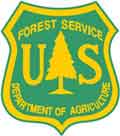 |
|
 |
|
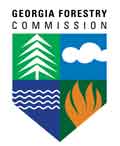 |
|
 |
USDA Forest Service
Public
lands in national
forests,
grasslands,
and recreation areas |
|
GA DNR
State
parks, recreation areas,
historic sites, and wildlife
management areas |
|
GA Forestry Commission
Georgia's forest resources, including forest management assistance to landowners
and communities |
|
YOU
Your private property |

|
Hemlocks all over north Georgia are being attacked and killed by the hemlock woolly adelgid (HWA),
and the beauty and value of your property are being threatened. As shown
on the most recent HWA Annual Spread Map provided by the Georgia Forestry Commission, infestations have been
officially confirmed in 19 counties -- Rabun, Habersham, Stephens, Banks, Towns, White, Hall, Union,
Lumpkin, Fannin, Gilmer, Pickens, Dawson, Murray, Whitfield, Cherokee, Gordon, Walker, and
Dade -- reaching as far west as Cloudland Canyon. HWA is also in other counties where hemlocks have been
planted in landscapes, including the Atlanta area.
If aggressive action is not taken soon to address this problem, the
results could be devastating and perhaps irreversible. |
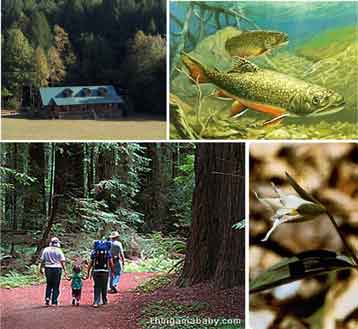 |
|
• loss of certain shade-loving native
plants
and the rise of invasive plants
• loss of certain animal species that
depend
on hemlocks
for food and habitat
• loss of the cool stream temperatures
that
trout need
• decline in the scenic enjoyment of
our mountains
• closure of trails and recreation areas due
to the danger of falling trees |
|
• increase in soil erosion
• degradation of water and air quality
• decline in revenue from outdoor
enthusiasts and
tourism
and the associated jobs
• increased exposure to drought and fire
risk
• decline in the beauty and value of
your property
• expense to remove dangerous dead trees |

SAVE GEORGIA'S HEMLOCKS offers the Hemlock Help Program, a statewide initiative
of education and charitable service to help north Georgians save as many
hemlocks as possible. It was implemented first in 2009 in Rabun County
where the HWA infestation began and
has been
deployed across the state on a county-by-county basis wherever the HWA is a
serious threat.
It is now available in all 19 counties
within the native hemlock range that have confirmed HWA infestation, as well as
non-native counties with hemlocks (including the Atlanta area) as needed.
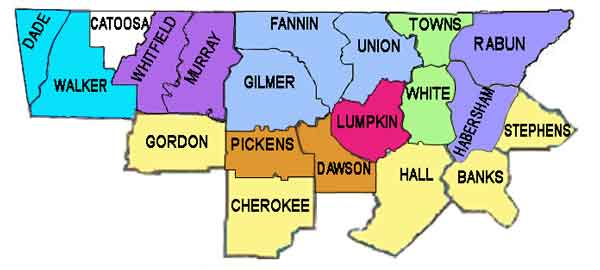

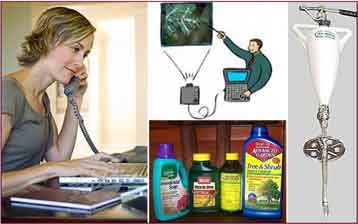 Save Georgia's Hemlocks offers a wide range of
educational and service programs such as those listed here, and we schedule
programs and activities year-round. We'll be glad to schedule special
programs or projects for property owner associations, conservation/recreation
organizations, schools, churches, and other community groups. Please call
the Hemlock Help Line 706-429-8010 to let us know of your interest and needs. Save Georgia's Hemlocks offers a wide range of
educational and service programs such as those listed here, and we schedule
programs and activities year-round. We'll be glad to schedule special
programs or projects for property owner associations, conservation/recreation
organizations, schools, churches, and other community groups. Please call
the Hemlock Help Line 706-429-8010 to let us know of your interest and needs.
•
Information and Advice:
* Hemlock Help LineSM
706-429-8010 to provide accurate, up-to-date answers to your questions about the hemlock woolly adelgid
crisis, treatment materials and methods, and concerns about product
effectiveness and safety. The Help Line is staffed 7 days a week and serves
the entire U. S. and Canada.
* On-site consultations with Volunteer Facilitators upon request.
•
Education:
* Free public Hemlock Help Clinics (see below), educational
materials, and publicity materials to raise
awareness of the HWA problem and solutions.
* Volunteer Facilitator training for individuals who want to learn more
about the hemlock problem and solutions and then be available to help others in
their community (see
Volunteer Facilitators page for the Volunteer Facilitator Job
Description).
* Tailored hemlock presentations for schools, scout troops, gardening groups,
environmental or recreational groups, and civic organizations.
•
Do-It-Yourself Support:
* Sources for
treatment products and application
equipment, and
treatment instructions
for
property owners who want to do the work themselves.
* Location of
soil injectors for
borrowing (most of which are provided by the Georgia Forestry Commission).
* Injector repair service for property owners, public land managers, and
pesticide professionals.
•
Professionals: Contact
information for
qualified local companies
that are properly licensed and insured and specialize in saving hemlocks for
property owners who prefer to contract with a professional to treat their trees.
•
Hemlock Help Project Planning: Assistance to neighborhoods and community groups
for developing customized project
management plans to address the HWA problem efficiently,
effectively, and economically. Please
see
Neighborhood
Hemlock Help Planning Guide.
•
New Trees:
* Healthy hemlock saplings offered for
adoption for landscape planting on private property or reforestation on public
land.
* Hemlock planting projects on
public lands.
•
Hemlock Treatment Projects:
* Through special agreements with the U. S. Forest Service and the Georgia
Department of Natural Resources, SGH-trained volunteers are able to treat
hemlocks on designated public lands.
* As time, funds, and volunteers are available, we will assist other
nonprofits and property owners on a charitable basis to treat their trees where
there is a need. Requests are evaluated on a case-by-case basis, and all
information is kept confidential.
•
Outreach:
* Hemlock raising projects and other environmental stewardship projects in
partnership with schools, churches, civic groups, and other nonprofits.
* Mentoring of other nonprofits or agencies that want to implement a
hemlock help program.
About Hemlock Help Clinics
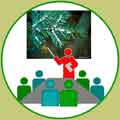 SGH Hemlock Help Clinics and presentations are free and open to the
public unless specifically noted on the
Schedule of Events page. SGH Hemlock Help Clinics and presentations are free and open to the
public unless specifically noted on the
Schedule of Events page.
A typical Hemlock Help Clinic lasts
1 to 1.5 hours (but can be adjusted) and includes:
•
Slide presentation on the HWA
crisis, economical steps property owners can take to treat their own trees, information
on qualified local professionals who do this work, and the free services
available through our Hemlock Help Program
•
Hands-on demonstration of using a soil
injector to treat hemlocks
•
Educational hand-out materials that
you are welcome to reproduce and share freely
•
Optional add-ons for school groups:
planting of hemlock seedlings in biodegradable cups for students to take home, planting of a hemlock sapling on campus,
or an educational hemlock hike.
•
Plenty of time for questions and
answers
When You Need Help for Your Hemlocks
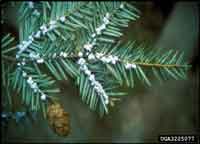 1. Inspect your hemlocks and see if
they're infested with woolly adelgids. The adelgids themselves are almost
too tiny to see with the naked eye, but their egg sacs are easily visible,
especially in the spring and late fall/winter. They
look like little white cotton balls on the underside of the branches, as shown in this photo. 1. Inspect your hemlocks and see if
they're infested with woolly adelgids. The adelgids themselves are almost
too tiny to see with the naked eye, but their egg sacs are easily visible,
especially in the spring and late fall/winter. They
look like little white cotton balls on the underside of the branches, as shown in this photo.
2. If you see ANY adelgids on even one of
your trees or if adelgids are within 25 miles of your property, plan to treat ALL the hemlocks you want to save as soon as possible. Call the Hemlock Help Line
706-429-8010
to learn about the treatment options, services available, costs,
and resources.
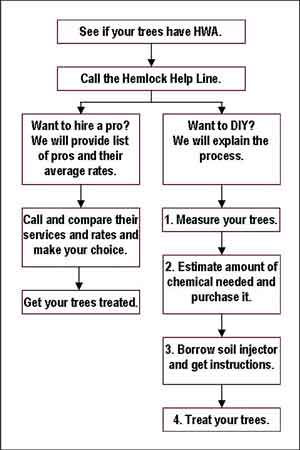 3. If you want to treat your own trees, the Hemlock Help Line
can provide information on
assessing the level of HWA infestation, determining the appropriate treatment
product and method, measuring your trees, estimating the amount of chemical
needed, and finding where to purchase it. Then download
Introduction to Treating Hemlocks and the appropriate one-page application
instruction from the
Resources page. 3. If you want to treat your own trees, the Hemlock Help Line
can provide information on
assessing the level of HWA infestation, determining the appropriate treatment
product and method, measuring your trees, estimating the amount of chemical
needed, and finding where to purchase it. Then download
Introduction to Treating Hemlocks and the appropriate one-page application
instruction from the
Resources page.
a. Measure the trunk diameter at
breast height for all the trees you want to treat and add up for a total.
b. Based on the chart in
Introduction to Treating Hemlocks, you can estimate the amount of product
needed. The Contacts page
lists the names of some stores where you can purchase it. We suggest that
you shop
and compare prices.
c. When you have the treatment product in hand,
you can either make arrangements to borrow an injector from one of the sources listed on the
Contacts page or choose another application
method.
NOTE: When you borrow an injector, you'll be asked to leave a deposit
which will be refunded when you return the injector. You should also request some brief hands-on training
from the lending entity or call the Hemlock Help Line for instruction.
d. Treat your hemlocks according to
the
application instructions.
e. If you borrow an injector, clean
it thoroughly as indicated in
Introduction to Treating Hemlocks and return it.
4. If you want to contract with a professional
to treat your trees, the Hemlock Help Line can
point you to a list of qualified local companies
along with their contact information.
We suggest that you shop and compare the services and rates offered by
each company. (See Contacts page.)
5. You can also call the Hemlock Help Line
706-429-8010 to request an on-site visit from a Volunteer Facilitator to help you assess the
infestation on your property, discuss appropriate treatment options, and assist
you to get started taking care of your hemlocks.
The Cost
The Hemlock Help
Program is designed to operate as a no-cost or low-cost charitable community
service. Here are the general cost guidelines for services included in the
Hemlock Help Program.
|
Service |
Cost |
|
Education |
Free |
|
Advice via Hemlock Help Line or Volunteer Facilitators |
Free |
|
Hemlock Help Project Planning |
Free |
|
Borrowing a soil injector -- See locations on Contacts page. |
Free with refundable deposit |
|
Healthy hemlock saplings --
with planting/care instructions.
• Seedlings <12" bare-root
•
Saplings
1 - 2'
tall in 1-gallon pots
• Saplings 3-5'
tall in pots or b&b |
Free to schools & nonprofits.
For personal adoptions, a modest donation is requested with amount based on size of
sapling. See Trees on Contacts page. |
|
Volunteer Hemlock Help Projects |
Labor is always provided at no cost. Normally, property owners purchase their own chemicals
or reimburse SGH for our chemicals that we use on their property, but charitable assistance may be available as SGH
resources permit. |
For property owners
who choose to treat their own trees or to contract with a professional to do the
treatment, here is information that will help in estimating the cost.
|
Treatment |
Cost |
|
Treating your own hemlocks -- Property owner is responsible for purchasing the required chemical. See list of
treatment product vendors
on Contacts page.
•
Lightly/moderately infested tree using Imidacloprid liquid or powder
•
Lightly/moderately infested tree using Imidacloprid dry tablets
•
Heavily infested or very large tree using Safari 20 SG |
Choice of
chemical should be based primarily on level of infestation.
DIY cost is then based on product used and trunk diameters.
About $0.04 - $0.36 / diameter inch
About $0.32 - $0.78
/ diameter inch
About $0.87 - $2.93 / diameter inch |
|
Hiring a professional to treat your hemlocks -- Property owner contracts directly with the professional.
See
Contacts
page for a list of
qualified
professionals.
•
Lightly/moderately infested tree using Imidacloprid
•
Heavily infested or very large tree using Safari |
Charges are based on
the level of infestation, trunk diameters, treatment product used, and
sometimes factors like terrain or number of trees.
Rates are
generally
within the following
average ranges:
About $0.50 - $4.00 / diameter inch
About $1.60 - $9.00 / diameter inch |

More
Information about the Hemlock Help Program
•
Call the Hemlock Help Line
706-429-8010.
•
Press Release -- Announcement of the initial
program launch in The Clayton Tribune and The
Rabun Town Crier, July 1, 2009.
•
Program
Description -- Planning document including problem statement, program
goal and objectives, guiding principles, scope, program services, and
financial management plan.
•
Visit the Resources
page for more Save Georgia's Hemlocks materials, related articles and
publications, and a list of helpful links.
| 